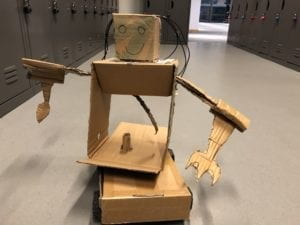My definition of interaction
I understand interaction as the process of two or more cognitive systems communicating, processing information, and then actively responding to each other. This process requires three key elements in order to qualify as interaction, which are 1) two or more actors, 2) cognitive systems, and 3) “listening, thinking and speaking” (Crawford 5).
A project that aligns with my definition
This project called “Tangibles World” created by Stella Speziali is a project that intertwines tactile experience with visual experience using VR and black boxes. The user puts on a VR helmet and reaches out a hand to one of the black boxes. The box will detect the hand and act accordingly with the hand movement, providing a designated tactile experience. While at the same time, the VR helmet provides a wonderful visual experience that fits the hand and eye movement.
Tangibles Worlds – Adding a sense of material and touch to VR
The project can act accordingly with your hand and your eye both visually and tactilely. It triggers my definition of interaction not because “both visually and tactilely” (though it is important), but because it acts “accordingly”. The key point I want to make is that it does not have a fixed pattern: the user experience varies between different people because of their different approaches. The user can choose wherever they look at and wherever they touch and the combinations of visual and tactile movements can be countless and thus the combined visual and tactile feedbacks can also be countless. What experience a user have almost depends entirely on their inputs.
A project that doesn’t align with my definition
This project called “Terra Mars” by Shi Weili uses AI to first learn the imagery information of Earth and then generate a new planet model using Mars’s data. The outcome is a planet that looks a lot like Earth but actually has the topographical data of Mars.
Terra Mars – ANN’s topography of Mars in the visual style of Earth
This project does not align with my definition of interaction because it does not involve more than one actor although it meets the criterion of “input, processing, and output”. The AI receives data, processes it, and then generates data. But it does not acts accordingly with the user – every one of the user has exactly the same experience. To put more radically, this project needs a spectator, but not a user.
Our group project
Our group project is basically a robot that feeds the user. It is called “Sfeeder”. It is designed to serve the user when he or she finds it difficult to eat food with their hands.


This is a project that best fits my definition of interaction. 1) It involves two or more actors: Sfeeder and users; 2) the actors are all cognitive systems that can perceive, think, and respond; 3) the interactive process requires input, processing, and output. Sfeeder detects what food that the user has at hand, and listens to what the user would like to have, and determines if the food is there, and then fetches the food and feeds the user. It can also order food for the user and offer health advice.
Similar to the first project I researched, both devices would detects the inputs from the user and act accordingly. What experience the user has almost entirely depends on what how the user interacts. In these two projects, every actor acts actively. For in our project, the user can choose whatever they would like to eat and then command the robot; and the robot can actively detect the food and give suggestions to the user on what to eat.
We started from the idea of human-centric because we believe that in the year of 2119, humans still exist in the world and whatever that lasts must be of some utility for human. So we decided to build an interactive device that is human-centric; it serves human needs interactively.
Regardless of that, although human is an important part of interaction, I do think interaction can happen without humans. A simple example is that a more sophisticated version of our Sfeeder can be used to feed a cat. And there is possibility that a robot serves another robot in the future.

